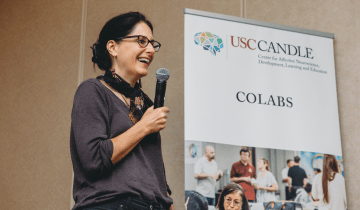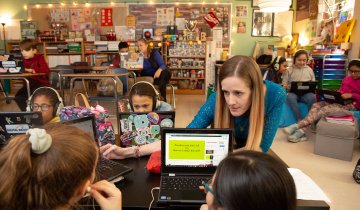In a classroom, motivation can go up and down. New research points to the ways that students can make the learning environment better for themselves—simply by asking their professors. USC Rossier professor Erika Patall became interested in this idea of agentic engagement—that is, students’ proactive contributions toward what goes on in the classroom—because she had previously researched how teachers can support student autonomy.
“I was intrigued by this idea of agentic engagement because it can sometimes be hard to reach teachers,” Patall says. She knew that teachers’ motivations are affected by what’s happening in the classroom and how their students respond, and she wanted to look “for a way to shape the climate from the student’s perspective.”
Research shows, in general, that supporting students’ experience of autonomy motivates them to be engaged in the learning process and improves learning outcomes. In a new research paper, Patall—along with USC Rossier researcher Joseph Vallin MAT ’17 and PhD candidates Jeanette Zambrano, Alana Kennedy and Nicole Yates—explored how that works. Patall studied students in college STEM courses, attempting to train them to consider their motivations as malleable and the classroom environment as changeable and responsive to their actions.
The process of agentic engagement sounds a lot more complicated than it looks in practice, Patall says. She explains that there are two elements: a belief component and a behavioral component. First, students must believe that their behaviors could change the classroom for the better. Second, students must behave agentically, asking questions, making suggestions, telling the instructor their preferences, or talking to their professor about what they need. “It’s basically thinking about what you need for this to be a better experience and acting to help the instructor make that happen,” she says.
The group studied the experiences of 706 college students in chemistry and physics classes and 359 students in psychology courses. The research included three small intervention studies in which students read articles and testimonials meant to persuade them of the benefits of asserting oneself in class, learned about strategies they could use in the classroom for being agentic, and engaged in writing exercises to help them internalize intervention ideas. When students filled out surveys at the end of the course, the studies found that the intervention were successful in changing students’ mindsets, compared with peers who didn’t complete the intervention. “If their mindset changed, that predicted students being more agentic in the class and being more engaged in other ways,” Patall says, which included their likelihood to continue in the subject.
Patall’s studies also tried to home in on the experience of underrepresented minority students in STEM classes, to see if agentic engagement strategies could help them succeed in their classes. She found that the intervention worked about the same across gender and racial groups, but she’s still interested in digging deeper into how the interventions could be targeted to benefit certain groups.
In the future, Patall plans to study engagement and motivation in high school students. She also wants to see if there are longitudinal benefits—if the strategy of being agentic in the classroom has lasting effects. Could it potentially change the course of a student’s academic career? Since the collegiate STEM path has a high rate of attrition, Patall would like to know how these strategies impact the long-term course of a student’s work.
And ultimately, she’d like to weave these student-centered interventions with ones that focus on teachers.
“Students can benefit from learning how to be agentic, but it breaks down and even can backfire when teachers aren’t responsive or discourage it in the first place,” says Patall. That can be especially frustrating to students who feel as if they are trying to make the classroom a better environment for everybody, she says. “How do we create an interaction that includes both training teachers and training students?”
In the end, she says her research shows how students’ being equipped with a sense of control over their motivation and a belief that they can impact the classroom environment is important for bringing about positive outcomes. “Anything that researchers, parents and teachers can do to support that belief is going to be beneficial to students’ engagement in their learning,” she says.





